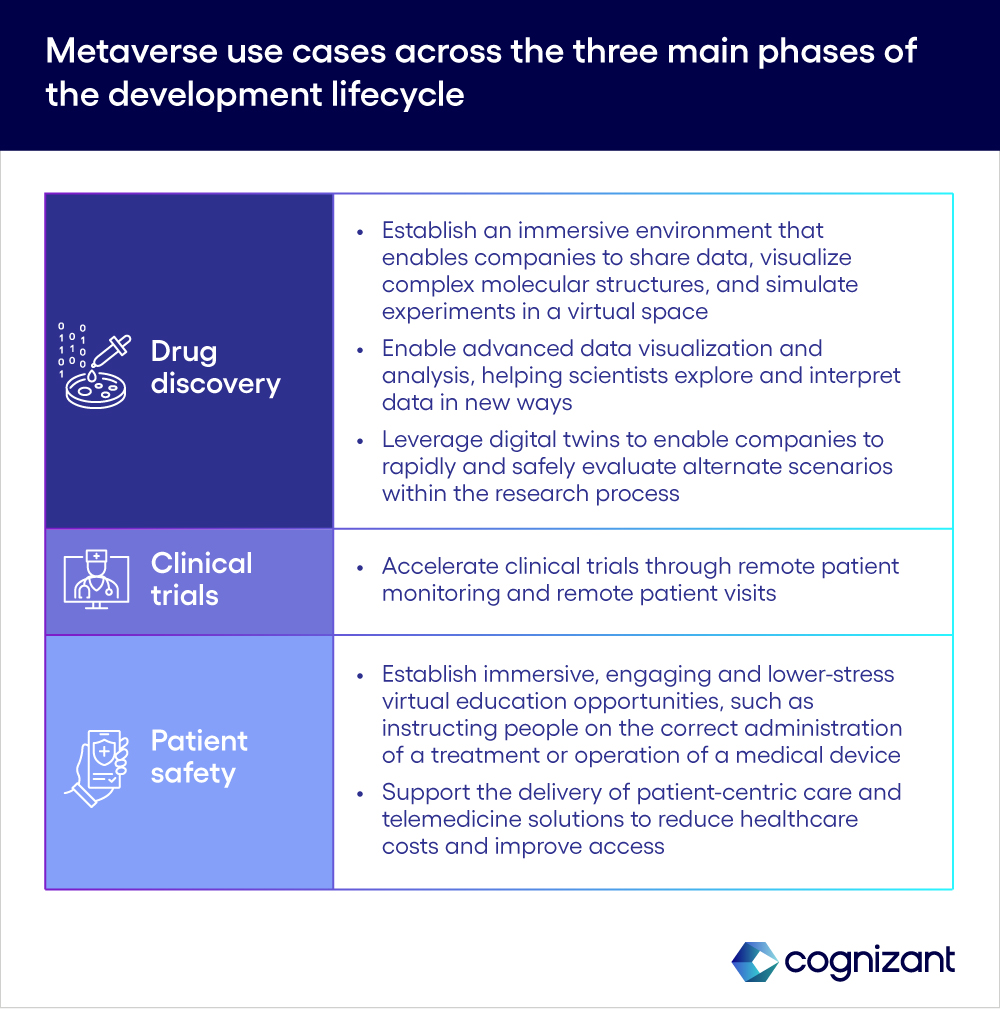September 11, 2023
The metaverse in life sciences: Seize the opportunity
The tech has been overhyped, but it holds exciting potential for the industry.
When it comes to the metaverse in the life sciences industry, the art of the possible has long been tempered by the reality of practical limitations.
Uncertainty about legal, compliance and security implications, coupled with a modest understanding among industry leaders of the capabilities of the metaverse and related technologies, has created a chorus of detractors who highlight challenges without acknowledging the outsized opportunity presented to those who overcome them.
Now, as excitement among consumers and analysts wanes and interest from major tech players drops, life sciences organizations seem to be even more likely to delay investments or initiatives in the digital realm.
But if the hype surrounding the metaverse has died down, the opportunity remains. While there are certainly issues to manage and momentum to build, life sciences organizations are doing themselves a disservice by failing to recognize the metaverse for what it is: a disruptive force that can jumpstart innovation at every stage of the development lifecycle, ultimately helping the industry deliver better outcomes to more people at a lower cost.
We’ll explore the potential of the metaverse for life sciences organizations and offer practical advice on how companies can adapt their mindset to harness the power of this new world.
Defining the metaverse in broad and bold terms
In a recent survey conducted in partnership with Pharmaceutical Executive, we found that just 13% of life sciences executives could accurately define the metaverse, so it’s no surprise that 72% of respondents have not even discussed a metaverse initiative.
About the survey: Cognizant partnered with Pharmaceutical Executive to survey 176 life sciences executives to learn more about how they view the metaverse and its viability to transform the industry.
Defined as an “interoperable, persistent space within which people can virtually travel, interact and perform a wide variety of tasks using a single identity,” the metaverse represents a valuable opportunity for companies of all kinds to identify new ways of working, enhance existing processes, collaborate with an expanded array of stakeholders and connect with the people the business serves.
But in life sciences, this opportunity is not driving action. While a combined 40% of life sciences executives in our survey view the metaverse as a “good” or “tremendous” opportunity, 29% remain neutral. Meanwhile, 54% agree or strongly agree that the metaverse is “over-hyped” as a business opportunity.
Even for those who recognize the value in this digital realm, questions abound about when, exactly, the potential of the metaverse will be realized. This uncertainty has fueled skepticism among life sciences leaders and delayed even modest investments.
In late 2022, we explored the opportunity of the metaverse for the life sciences industry. You can find that report here.
Embracing new use cases
In our survey, 64% of respondents said they saw the greatest opportunity for the metaverse in the commercial arena, including sales, marketing, training and development—areas in which they’d seen use cases. Only one-quarter cited research as a great opportunity, while 21% and 16% cited medical affairs and manufacturing, respectively.
But the metaverse is more than digital events and development courses; it’s a vehicle for rapid revolution at scale.
There are many viable metaverse use cases beyond commercial applications. For example, during the Covid-19 pandemic, pharmaceutical companies deployed mobile health units to enable remote patient monitoring services as well as remote clinical trials. This offered huge benefits to patients in terms of continuity of care and safety, while also improving access, especially among people who live in remote or rural locations.
Now imagine companies had incorporated a metaverse element into these programs. What if the van was eliminated, and instead patients performed monitoring or followed treatment regimens in their home?
With a combination of immersive virtual reality content and metaverse technology, patients and caregivers could learn to use equipment, take readings and share results. Telehealth meetings could be arranged between healthcare professionals and patients automatically when key metrics fell outside the acceptable range. The metaverse could also be used to set up virtual support groups for patients and their families, helping to build a sense of community at a time when people were unable to socialize or network in the traditional sense.
Due to timing and regulatory and security concerns, the metaverse wasn’t generally available during the pandemic, but imagine the benefits if it had been: Continuous care through in-home services; improved access through remote services; higher engagement and stronger adherence brought about by eliminating the need to travel to appointments and creating a virtual support network; and reduced complexity due to the elimination of physical units. Naturally, all of this could drive better outcomes at a lower cost.
While there is still some metaverse uncertainty around regulations, hardware selection, platform providers and other key issues, companies should not fall into the trap of waiting for all the answers to emerge. They must play an active role in charting the course ahead and leverage evolving technologies to propel their business forward.
Figure 1
Challenges to overcome, uncertainty to address
In an industry that must guarantee patient safety and data security, the metaverse is not without its challenges. Our survey confirmed that there is no shortage of barriers, perceived or actual, to the evolution and adoption of the metaverse, particularly when it comes to more advanced use cases.
Figure 2
While we cannot argue the presence of challenges, it is important to consider those issues on a deeper level. Does the concern stem from a real and specific risk posed by using a new technology? Or is the organization resistant to change because it is simply unfamiliar with the technology being used? Has the organization evaluated avenues to mitigate risk? Or has it set aside use cases without fully exploring the options?
While industry executives may have a knee-jerk reaction to metaverse initiatives because they leverage emerging technologies, this mindset overlooks an opportunity for innovation.
Figure 3
Organizing around adaptability, reusability and sustainability
Rather than thinking about specific challenges associated with the metaverse, we recommend that companies consider their strategy more holistically across three areas:
- Adaptability: Determine how metaverse initiatives and investments can be developed and applied to support future, more advanced or broader use cases.
- Reusability: Identify the ROI of initiatives and the company’s ability to drive value from investments.
- Sustainability: Determine what measures will ensure that the program’s value will grow over time, most likely through integration with future technologies that make the original foundation more powerful.
Cutting across all three of these pillars is the issue of data security and patient privacy, the challenge of which cannot be underestimated. At the same time, security constraints and data management issues will always exist with any initiative, period. To discount the metaverse simply because it introduces risk is to overlook the value of any new technology or tool on the grounds that it has not been widely used before.
Four steps to take when embracing the metaverse in life sciences
1. Foster a culture of experimentation and innovation
The metaverse requires companies to not only do new things but do existing things differently. To do so, life sciences organizations must foster a culture of innovation. Without this culture, building support across the business for the metaverse (or any other transformation initiative) will be extremely difficult, even with designated leadership and substantial budget allocations.
Could advances in haptic technology lead to a breakthrough in remote care?
Researchers at the City University of Hong Kong recently unveiled WeTac, a glove that leverages an advanced wireless haptic interface system to collect personalized tactile sensation data and provide a realistic, detailed touch experience. Unlike current haptic gloves, which are bulky and controlled through cords and cables, WeTac uses simulation pixels and requires no external power source. This allows the glove to be incredibly soft and thin, making it highly appealing for a variety of use cases.
For example, WeTac could enable physicians to conduct a physical exam remotely, “feeling” the texture of certain skin conditions or sensing temperature. The gloves could also be used for training, providing healthcare professionals with a realistic sense of the size and feel of medical equipment within the context of human anatomy.
2. Define a centralized metaverse strategy within the transformation agenda
Metaverse initiatives should fit within the organization’s broader transformation strategy, the overarching goal of which should be to keep pace with the rapidly changing technology landscape and leverage those technologies to drive value.
At the same time, the metaverse warrants its own plan within the transformation agenda. This centralized strategy should guide the organization in selecting use cases, defining initiatives, making investments, allocating resources and evolving over time. Once a centralized strategy is in place, it can be rolled out in various initiatives across different teams and functions.
3. Advance the agenda with strategic partnerships
The metaverse is an area in which partnerships carry a significant value. Unlike other technologies or platforms, in which partnerships are formed on a one-to-one or one-to-few bases, in the metaverse, companies have the ability to create partnerships on the level of one-to-n. It is a virtual space where creativity only grows.
Given that the metaverse is still developing, having a multitude of strategic partnerships can help unlock higher levels of performance. Relationships, including those with niche players and startups as well as larger business transformation services providers, are an important way to bridge the technology and skills gaps that often exist in non-tech companies.
4. Cultivate talent to quickly seize new opportunities
To fully leverage the metaverse, life sciences organizations need access to the right talent with the right skills. Cultivating talent, either in conjunction with technology partners or via traditional development programs, is the key to adapting existing platforms to meet advanced needs.
Given that talent in the metaverse arena is in high demand now and will continue to be, companies should take steps to begin this process now. Building skills within a core, dedicated team will help ensure the business can deliver on use cases now and quickly adapt to future initiatives as the metaverse matures.
The case for urgency to seize opportunity
In life sciences, fortune rewards the brave. The metaverse has the potential to reinvent the industry, transforming patient experiences and unlocking new ways of working for life sciences professionals.
In the next decade, as metaverse technology continues to advance and companies develop their core capabilities, new leaders will emerge. The winners of tomorrow will be those that recognize the potential of the technology and understand the need to find solutions to their practical concerns related to regulation, privacy and security.
While the complexity of change will no doubt be challenging, evolution is at the core of the life sciences industry. We see the metaverse and surrounding technologies as playing an integral role in helping companies deliver better care to more people at a lower cost.
The question is: Will your organization play a leading role in this future and join us in exploring the art of the possible—or will you let opportunity pass you by?
To learn more, visit the Life Sciences section of our website or contact us.
This article was written by Gaurav Sharma, Client Partner; Bryan Hill, Vice President in Cognizant’s Life Sciences practice; and Duncan Roberts, Senior Manager in Cognizant Research.
We’re here to offer you practical and unique solutions to today’s most pressing technology challenges. Across industries and markets, get inspired today for success tomorrow.
Latest posts
Related posts
Get actionable business Insights in your inbox
Sign up for the Cognizant newsletter to gain actionable AI advice and real-world business insights delivered to your inbox every month.

















